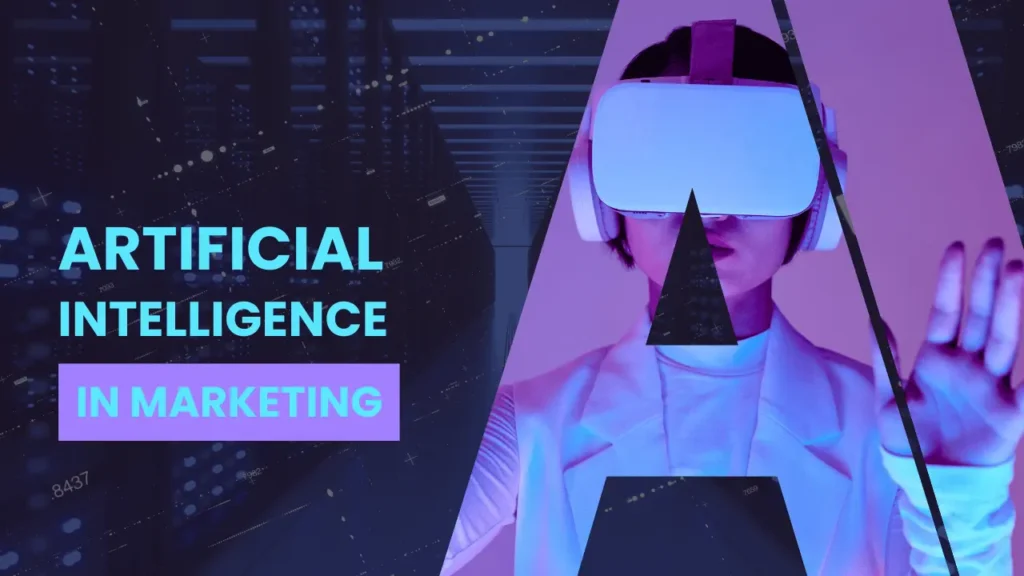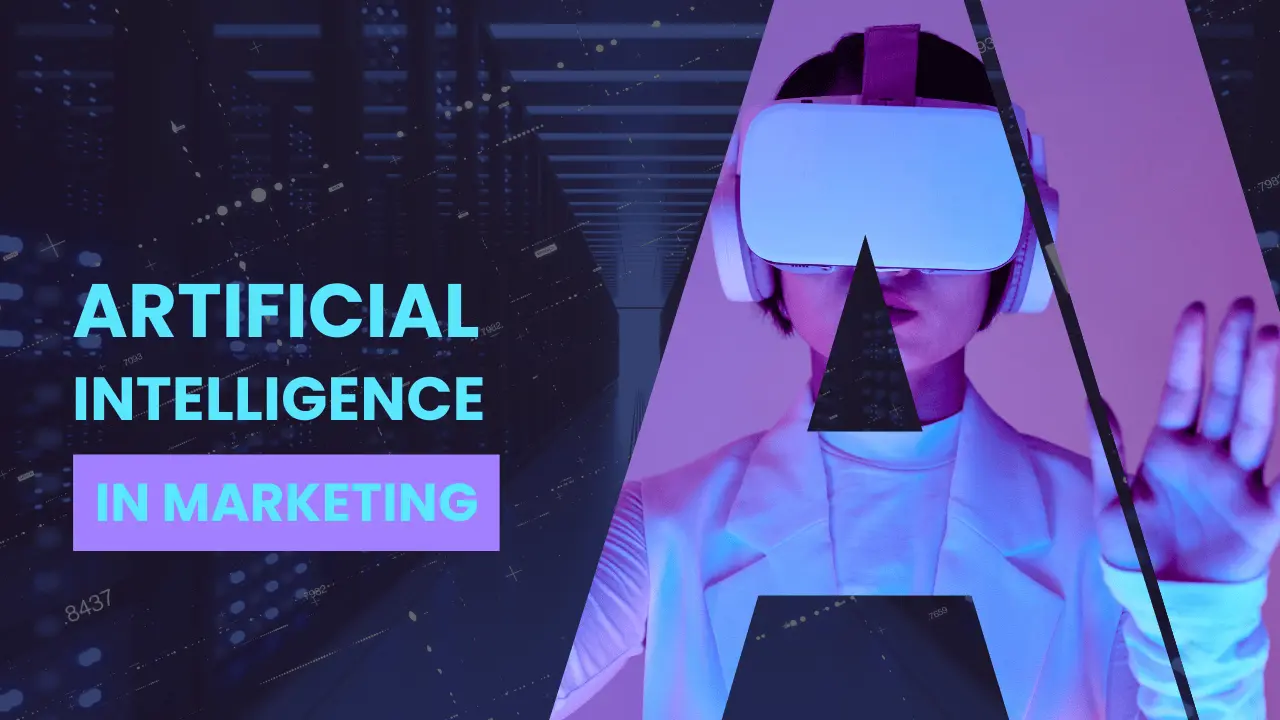Table of Contents
Introduction
Artificial intelligence (AI) was once an advanced technology handled by a select few specialists. Today, AI is ubiquitous, embedded in everyday devices, and increasingly pivotal in marketing. This article explores how AI is reshaping marketing, providing valuable insights and examples for marketers aiming to leverage AI’s potential.
AI is not just a technological marvel; it represents a paradigm shift in how businesses interact with customers, make decisions, and optimize operations. The integration of AI into marketing processes has created new opportunities and challenges, necessitating a deeper understanding of its capabilities and applications. This comprehensive guide will delve into the multifaceted role of AI in marketing, offering a roadmap for marketers to navigate this transformative landscape.
AI Definition and History
What is AI?
AI, short for Artificial Intelligence, refers to machines or software that mimic human intelligence. According to the Japanese Society for Artificial Intelligence, AI is a machine behaving like a human. John McCarthy, who coined the term, describes it as an “intelligent computer program.”
AI encompasses a wide range of technologies, including machine learning, natural language processing, and robotics. These technologies enable machines to learn from experience, understand complex data, perform human-like tasks, and improve over time. AI’s ability to process vast amounts of data and make decisions based on that data is what sets it apart from traditional computing systems.
Evolution of AI
AI was first proposed at the Dartmouth Conference in 1956 by John McCarthy. Since then, AI has evolved through various phases, each marked by significant advancements and renewed interest. The early years saw the development of basic algorithms and symbolic AI, which laid the foundation for more complex systems.
The First AI Boom
The first AI boom occurred in the 1950s and 1960s, characterized by optimism and significant funding. Researchers developed early AI programs capable of solving algebra problems, proving theorems, and playing games like chess. However, the limitations of these early systems soon became apparent, leading to a period known as the “AI winter,” where interest and funding waned.
The Second AI Boom
The second AI boom in the 1980s and early 1990s was driven by the development of expert systems. These systems used rule-based logic to mimic the decision-making abilities of human experts in specific domains, such as medical diagnosis and financial analysis. Despite their initial success, expert systems struggled with scalability and adaptability, leading to another AI winter.
The Third AI Boom
The third AI boom began around 2010, fueled by advancements in machine learning, increased computational power, and the availability of large datasets. This period saw the rise of deep learning, a subset of machine learning that uses neural networks to model complex patterns in data. The success of deep learning in tasks such as image and speech recognition reignited interest in AI, leading to widespread adoption across various industries.
Current State of AI
Since 2020, AI’s role has rapidly expanded, deeply integrating into various societal sectors. Today, AI is used in healthcare, finance, transportation, and, notably, marketing. Its ability to analyze data, predict trends, and automate tasks has made it an invaluable tool for businesses looking to enhance their marketing strategies.
Classification of AI
Understanding the different types of AI is crucial for marketers looking to leverage this technology. AI can be classified based on its capabilities and applications.
Specialized AI vs. General-Purpose AI
- Specialized AI: Focuses on specific tasks like image or voice recognition. Most current AI applications fall into this category. Specialized AI systems are designed to perform a single function or a narrow range of functions, making them highly efficient in their respective areas. Examples include recommendation algorithms used by streaming services and customer service chatbots.
- General-Purpose AI: Envisioned to handle a wide range of tasks, similar to the human brain. This type of AI remains largely theoretical. General-purpose AI aims to possess the ability to understand, learn, and apply knowledge across various domains, adapting to new situations and tasks without human intervention.
Strong AI vs. Weak AI
- Strong AI: Possesses human-like consciousness and can independently process information and tasks. Strong AI, also known as artificial general intelligence (AGI), is capable of performing any intellectual task that a human can do. It remains a theoretical concept and has not yet been realized.
- Weak AI: Limited to specific tasks without independent thought, akin to specialized AI. Weak AI, also known as narrow AI, is designed to perform particular tasks efficiently but lacks generalization capabilities. Most of the AI systems in use today fall into this category, including virtual assistants like Siri and Alexa.
Machine Learning and Deep Learning
- Machine Learning: A subset of AI that enables systems to learn and improve from experience without being explicitly programmed. Machine learning algorithms analyze data, identify patterns, and make decisions based on their findings. Applications include email filtering, fraud detection, and recommendation systems.
- Deep Learning: A subset of machine learning that uses neural networks with many layers to model complex patterns in data. Deep learning has been particularly successful in tasks such as image and speech recognition, natural language processing, and autonomous driving.
Possibility of Using AI in Marketing
Applications of AI in marketing is vast, from data analysis to customer behavior prediction. Here are key areas where AI is making an impact:
Data Analysis
AI enhances data analysis by automating data integration and processing. It provides actionable insights from customer survey results and purchase histories, thus saving time and effort for marketers. AI can handle vast amounts of data with speed and accuracy that far surpasses human capabilities, making it an invaluable tool for data-driven decision-making.
Predictive Analytics
Predictive analytics uses AI algorithms to analyze historical data and predict future trends. In marketing, predictive analytics can forecast customer behavior, identify potential leads, and optimize marketing campaigns. By understanding what customers are likely to do next, marketers can tailor their strategies to meet customer needs more effectively.
Customer Segmentation
AI can segment customers into distinct groups based on their behavior, preferences, and demographics. This segmentation allows marketers to create personalized campaigns that resonate with specific audience segments. For example, AI can identify high-value customers and target them with exclusive offers, increasing customer loyalty and retention.
People Flow Analysis
AI with image recognition can analyze in-store customer behavior, optimizing staffing and sales strategies. For instance, Trial Company Co., Ltd. uses AI to improve customer service efficiency and alleviate congestion in its stores.
Heat Mapping
Heat mapping uses AI to track and visualize customer movement within a store. By analyzing these patterns, retailers can optimize store layouts, product placement, and promotional displays. Heat mapping can reveal which areas of the store attract the most foot traffic and which products are most frequently interacted with, enabling data-driven decisions to enhance the shopping experience.
Queue Management
AI can also be used to manage queues and reduce wait times in retail environments. By analyzing customer flow and predicting peak times, AI systems can allocate staff more efficiently and implement strategies to alleviate congestion. This improves customer satisfaction and can lead to increased sales.
Advertising Operation
AI automates advertising operations, particularly in digital media. It optimizes ad bidding processes, as seen with Nitori Holdings Co., Ltd., which uses Google’s AI system to reduce advertising costs and increase store visits.
Programmatic Advertising
Programmatic advertising uses AI to automate the buying and selling of ad space in real-time. AI algorithms analyze user data to deliver targeted ads to the right audience at the right time. This increases the efficiency and effectiveness of advertising campaigns, leading to higher conversion rates and better return on investment (ROI).
Ad Personalization
AI can personalize ads based on individual user behavior and preferences. By analyzing data such as browsing history, purchase behavior, and social media activity, AI can create highly targeted ads that resonate with each user. This level of personalization can significantly enhance engagement and conversion rates.

Key Points for Utilization of AI in Marketing
Marketers can effectively harness AI in Marketing by following these steps:
Four Steps for Marketers to Master AI in Marketing
- Learn the Basics of AI in Marketing: Understand fundamental AI concepts. Familiarize yourself with key terms such as machine learning, neural networks, and natural language processing.
- Experience Building AI in Marketing: Gain hands-on experience with AI projects. This could involve participating in AI workshops, online courses, or collaborative projects within your organization.
- Learn AI in Marketing Cases: Study successful AI implementations in marketing. Analyze case studies and real-world examples to understand how AI has been used to solve marketing challenges and achieve business objectives.
- Refine AI in Marketing Planning Abilities: Develop strategies to integrate AI into marketing plans. This involves identifying specific use cases for AI in your marketing activities, setting clear goals, and measuring the impact of AI initiatives.
Types of AI in Marketing Functions
AI functions are divided into four main categories:
- Discrimination System: Identifies patterns. Used in applications such as image and voice recognition, fraud detection, and quality control.
- Prediction System: Forecasts future trends. Applied in areas like predictive analytics, demand forecasting, and risk assessment.
- Conversation System: Manages interactions. Examples include chatbots, virtual assistants, and customer service automation.
- Execution System: Performs tasks. Includes robotic process automation (RPA), autonomous vehicles, and smart home devices.
Each function can be further categorized into human substitution and human augmentation types, crucial for selecting the right AI for marketing needs. Human substitution AI replaces tasks traditionally performed by humans, while human augmentation AI enhances human capabilities, allowing marketers to make more informed decisions and execute tasks more efficiently.
Best Practices for Implementing AI in Marketing
To successfully implement AI in marketing, consider the following best practices:
- Start Small: Begin with pilot projects to test AI applications in a controlled environment. This allows you to evaluate the effectiveness of AI without significant investment or risk.
- Collaborate with Experts: Partner with AI experts or consult with AI vendors to leverage their expertise and resources. This can help you avoid common pitfalls and accelerate the implementation process.
- Focus on Data Quality: High-quality data is essential for effective AI. Ensure that your data is accurate, comprehensive, and up-to-date. Implement data governance practices to maintain data integrity.
- Measure and Optimize: Continuously monitor the performance of AI initiatives and make data-driven adjustments. Use key performance indicators (KPIs) to evaluate the impact of AI on marketing goals and identify areas for improvement.
AI in Marketing Use Cases
Haruyama Trading Co., Ltd.
Haruyama Trading uses SENSY, an AI that analyzes individual preferences to recommend products. This personalization has significantly increased store visit rates. SENSY is a personal artificial intelligence that learns each customer’s preferences and suggests products tailored to their tastes.
Personalized Direct Mail
Haruyama Trading implemented SENSY to personalize direct mail (DM) campaigns. By analyzing customer data, SENSY creates customized DM content for each recipient, resulting in higher engagement and response rates. The personalized DM strategy led to a 159% increase in store visits compared to traditional DM campaigns.
Job Hunting Suit Recommendations
Haruyama Trading also introduced a service for job-hunting students, utilizing AI to recommend suitable outfits. Students provide personal data such as their desired industry, image, face shape, and body type. The AI then suggests coordinated outfits, enhancing the shopping experience and increasing sales.
Nitori Holdings Co., Ltd.
Nitori uses Google’s AI to automate ad bidding, resulting in a 36% increase in store visits and reduced advertising costs. The AI system predicts user behavior and adjusts ad bids in real-time, optimizing the allocation of advertising budgets.
O2O Marketing
Nitori focuses on online-to-offline (O2O) marketing, using online ads to drive traffic to physical stores. The AI-powered ad bidding system targets potential customers who are likely to visit the store, increasing foot traffic and sales. This approach has streamlined Nitori’s advertising operations and improved overall marketing effectiveness.
IDOM Co., Ltd.
IDOM employs ABEJA Dashboard to analyze customer behavior in stores, leading to a 10% increase in car sales by optimizing store layouts and customer service. ABEJA Dashboard uses AI to process data from in-store cameras and sensors, providing insights into customer movement and interactions.
Store Layout Optimization
By visualizing customer behavior, IDOM can identify high-traffic areas and optimize product placement. This data-driven approach ensures that popular products are easily accessible, enhancing the shopping experience and boosting sales.
Enhanced Customer Service
AI also helps IDOM improve customer service by analyzing interactions and identifying areas for improvement. For example, AI can suggest optimal staffing levels based on predicted foot traffic, ensuring that customers receive prompt and attentive service.
Challenges and Considerations
While AI offers numerous benefits for marketing, it also presents several challenges and considerations that marketers must address to ensure successful implementation.
Data Privacy and Security
AI systems rely on vast amounts of data, often including sensitive customer information. Ensuring data privacy and security is paramount to maintaining customer trust and complying with regulations such as the General Data Protection Regulation (GDPR).
Ethical AI Use
Marketers must consider the ethical implications of AI, including issues related to bias and fairness. AI algorithms can inadvertently perpetuate existing biases present in the training data, leading to unfair or discriminatory outcomes. Implementing fairness and transparency measures is crucial to mitigate these risks.
Integration with Existing Systems
Integrating AI with existing marketing systems and workflows can be challenging. Ensuring compatibility and seamless data flow between AI and other tools is essential for maximizing AI’s potential.
Scalability
Scalability is another consideration when implementing AI in marketing. As AI applications grow, the infrastructure and resources required to support them must also expand. Marketers need to plan for scalability to accommodate increased data volumes and processing demands.
Cost and Resource Allocation
Implementing AI can be costly, requiring significant investment in technology, talent, and training. Marketers must carefully assess the cost-benefit ratio and allocate resources efficiently to ensure a positive return on investment.
Talent and Expertise
The shortage of AI talent is a significant barrier to AI adoption. Marketers may struggle to find and retain skilled professionals capable of developing, implementing, and managing AI systems. Investing in training and development programs can help build in-house expertise.
For more read us :
Future Trends of AI in Marketing
AI is continuously evolving, and several emerging trends are poised to shape the future of marketing. Staying informed about these trends can help marketers stay ahead of the curve and leverage new opportunities.
AI-Driven Content Creation
AI is increasingly being used to create content, from blog posts and social media updates to personalized marketing messages. AI-driven content creation tools use natural language processing to generate high-quality, relevant content at scale.
Personalized Content
Personalized content is becoming more sophisticated, with AI analyzing customer data to create highly tailored marketing messages. This trend enhances customer engagement and drives higher conversion rates by delivering content that resonates with individual preferences and behaviors.
Voice Search and Voice-Activated Assistants
The rise of voice search and voice-activated assistants, such as Amazon’s Alexa and Google’s Assistant, is transforming how consumers search for information and interact with brands. Marketers need to optimize their content for voice search to ensure visibility in this growing channel.
Conversational AI
Conversational AI, including chatbots and virtual assistants, is improving customer interactions and support. These AI systems can handle a wide range of tasks, from answering queries and providing recommendations to processing transactions, enhancing the customer experience and reducing response times.
AI-Enhanced Customer Experience
AI is enhancing the overall customer experience by providing personalized, seamless interactions across multiple touchpoints. From personalized product recommendations to proactive customer support, AI is helping brands deliver exceptional experiences that drive customer loyalty.
Predictive Customer Service
Predictive customer service uses AI to anticipate customer needs and address issues before they arise. By analyzing historical data and identifying patterns, AI can predict when a customer might need assistance and proactively offer support, improving satisfaction and reducing churn.
Integration of AI with Augmented Reality (AR) and Virtual Reality (VR)
The integration of AI with AR and VR is creating immersive marketing experiences. AI-powered AR and VR applications can personalize virtual environments, offer interactive product demonstrations, and enhance storytelling, providing unique and engaging experiences for customers.
AI and Blockchain
The combination of AI and blockchain technology is emerging as a powerful tool for marketing. Blockchain ensures data transparency and security, while AI analyzes and leverages this data to optimize marketing strategies. This synergy can enhance data integrity, improve targeting, and build customer trust.
Sustainability and Ethical AI
As consumers become more environmentally conscious, AI is being used to promote sustainability in marketing. AI can optimize supply chains, reduce waste, and support eco-friendly practices. Additionally, there is a growing emphasis on developing ethical AI systems that prioritize fairness, transparency, and social responsibility.
For more follow us :
FAQs
How can be AI in marketing efficiency improved?
AI automates data analysis, customer behavior prediction, and advertising operations, saving time and enhancing accuracy. By streamlining processes and providing actionable insights, AI helps marketers make data-driven decisions, optimize campaigns, and achieve better results.
What are the types of AI in marketing used?
Specialized AI and weak AI are predominantly used, focusing on specific tasks like data analysis and ad optimization. These AI systems are designed to perform particular functions efficiently, such as segmenting customers, predicting trends, and personalizing content.
Can AI personalize customer experiences?
Yes, AI can analyze individual preferences and behavior to provide personalized recommendations and services. By leveraging data from various sources, AI can deliver highly tailored marketing messages and offers, enhancing customer engagement and satisfaction.
How can we start using AI in Marketing?
Marketers should begin by understanding basic AI concepts, gaining hands-on experience, studying AI use cases, and developing AI-integrated strategies. Starting with pilot projects and collaborating with AI experts can help marketers build confidence and expertise in using AI effectively.
What are the challenges of implementing AI in marketing?
Challenges include data privacy and security, ethical considerations, integration with existing systems, scalability, cost, and talent acquisition. Addressing these challenges requires careful planning, investment in resources, and a commitment to ethical AI practices.
What future trends should AI in Marketing watch for?
Emerging trends include AI-driven content creation, voice search optimization, conversational AI, AI-enhanced customer experiences, integration with AR and VR, AI and blockchain synergy, and the focus on sustainability and ethical AI. Staying informed about these trends can help marketers leverage new opportunities and stay competitive.
Conclusion
AI is revolutionizing marketing by automating processes, personalizing customer interactions, and providing deep insights through data analysis. As AI technology continues to advance, its role in marketing will only grow, making it essential for marketers to adapt and leverage AI to stay competitive.
Incorporating AI into your marketing strategy can drive efficiency, enhance customer experiences, and ultimately boost business performance. By understanding AI’s capabilities and learning how to utilize them effectively, marketers can harness the power of AI to achieve remarkable results.





